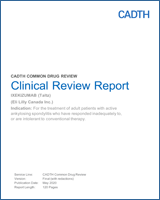Results at 16 Weeks
Clinical response (i.e., ASAS 40 and ASAS 20): At week 16, in both COAST-V and COAST-W, it was reported that a statistically and clinically significant greater proportion of patients treated with IXE 80 mg SC every four weeks achieved ASAS 40 and ASAS 20 than patients with placebo treatment. Twenty-eight percent more patients in the IXE group in COAST-V and 19% more patients in COAST-W achieved ASAS 40 than those in the placebo group, respectively. According to the clinical expert CADTH consulted for this review, ASAS 20 at week 12 is considered an acceptable clinical response for the bDMARDs trial in AS; therefore, ASAS 40 at week 16 was considered as a major clinical improvement. The response rates of ASAS 40 and ASAS 20 reported in both COAST-V and COAST-W are considered clinically meaningful. It is also noted that the ASAS 40 and ASAS 20 response to the IXE treatment were greater in the COAST-V than that in COAST-W, which reflects that patients included in COAST-W who responded to, or were intolerant to TNFis were more difficult to treatment.
Symptoms reduction: In both COAST-V and COAST-W, patients treated with IXE compared with placebo appeared to have a numerically greater reduction in spinal pain and greater improvement in fatigue (measured with fatigue NRS); IXE treatment also showed some benefit in improving sleep and depression. Since these individual symptom measurements were analyzed with no multiplicity adjustment, the statistical significance (P value) remains uncertain. In addition, no MID was identified for these symptom measurement scales. However, the most important symptom, spinal pain, is a main component of ASAS criteria. It is therefore reasonable to believe that the observed difference of spinal pain between IXE treatment and placebo maybe clinically meaningful.
Function and disability improvement (i.e., BASFI): It was observed that there were statistically and clinically significant greater improvement in BASFI in patients receiving IXE 80 mg SC every four weeks than in patients with placebo based on the MID for BASFI (MID = 0.6 units on a 10-unit scale).
Quality of life improvement: In terms of quality of life measured by SF-36 PCS in both COAST-V and COAST-W, a statistically and clinically significant greater improvement was observed in patients receiving IXE 80 mg SC every four weeks than in patients with placebo based on the MID of SF-36 (MID = 2.5 to 5 points). In terms EQ-5D-5L, a notable difference between IXE treatment and placebo in favour of IXE treatment was also observed. As EQ-5D-5L was analyzed with no multiplicity adjustment, the statistical significance for EQ-5D-5L remains uncertain. ▬▬▬▬▬ Therefore, the benefit of IXE 80 mg SC every four weeks treatment compared with placebo in terms of EQ-5D-5L may still be considered clinically meaningful. As to ASAS HI, a statistically significant greater improvement was observed in patients treated with IXE 80 mg SC every four weeks than patients with placebo. Since there are no MID identified for ASAS HI, whether or not the between-group difference of ASAS HI is clinical meaningful remains unknown.
Work productivity (i.e., WPAI-SpA Score): Some numerical benefit was also observed in favour of IXE treatment compared with placebo. However, since the WPAI-SpA was analyzed with no multiplicity adjustment, the statistical significance remains uncertain. In addition, no MID was identified for WPAI-SpA, therefore, whether or not the between-group difference of the WPAI-SpA score between IXE and placebo is clinically meaningful remains unclear.
Disease activity reduction: A statistically and clinically significant greater reduction in disease activity was reported in patients receiving IXE 80 mg SC every four weeks than in patients receiving placebo in terms of BASDAI 50 in COAST-V. ASDAS change from baseline in both COAST-V and COAST-W was based on respective MID. The MID was two units for BASDAI and 1.1 for ASDAS, respectively. A statistically significant BASDAI change from baseline in the IXE group compared with placebo was observed in COAST-W.
A notable treatment difference with respect to PGA was also observed in favour of IXE treatment compared with placebo. However, since PGA were analyzed with no multiplicity adjustment, the statistical significance remains uncertain. In addition, no MID was identified for PGA. However, PGA is a main component of ASAS criteria. Therefore, it is reasonable to conclude that the observed difference of PGA between IXE treatment and placebo may be clinically meaningful.
MRI Spine SPARCC score: In both COAST-V and COAST-W, compared with placebo, treatment with IXE showed a statistically and clinically significant greater improvement based on MID, with MID being five units for MRI Spine SPARCC).
Overall, the magnitude of treatment response to IXE was less in TNFi-experienced patients in COAST-W compared with bDMARD-naive patients in COAST-V, which reflects that patients included in COAST-W who inadequately responded to, or were intolerant to TNFis were more difficult to treat.

